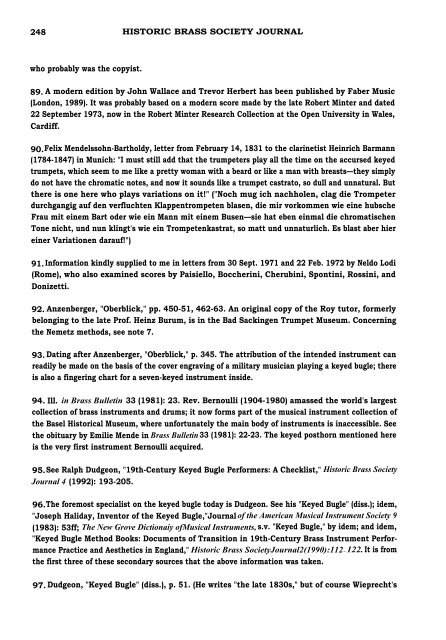THE ROMANTIC TRUMPET - Historic Brass Society
THE ROMANTIC TRUMPET - Historic Brass Society
THE ROMANTIC TRUMPET - Historic Brass Society
You also want an ePaper? Increase the reach of your titles
YUMPU automatically turns print PDFs into web optimized ePapers that Google loves.
248 HISTORIC BRASS SOCIETY JOURNAL<br />
who probably was the copyist.<br />
89. A modern edition by John Wallace and Trevor Herbert has been published by Faber Music<br />
(London, 1989). It was probably based on a modern score made by the late Robert Minter and dated<br />
22 September 1973, now in the Robert Minter Research Collection at the Open University in Wales,<br />
Cardiff.<br />
90. Felix Mendelssohn-Bartholdy, letter from February 14, 1831 to the clarinetist Heinrich Barmann<br />
(1784-1847) in Munich: "I must still add that the trumpeters play all the time on the accursed keyed<br />
trumpets, which seem to me like a pretty woman with a beard or like a man with breasts—they simply<br />
do not have the chromatic notes, and now it sounds like a trumpet castrato, so dull and unnatural. But<br />
there is one here who plays variations on it!" ("Noch mug ich nachholen, clag die Trompeter<br />
durchgangig auf den verfluchten Klappentrompeten blasen, die mir vorkommen wie eine hubsche<br />
Frau mit einem Bart oder wie ein Mann mit einem Busen—sie hat eben einmal die chromatischen<br />
Tone nicht, und nun klingt's wie ein Trompetenkastrat, so matt und unnaturlich. Es blast aber hier<br />
einer Variationen darauf!")<br />
91. Information kindly supplied to me in letters from 30 Sept. 1971 and 22 Feb. 1972 by Neldo Lodi<br />
(Rome), who also examined scores by Paisiello, Boccherini, Cherubini, Spontini, Rossini, and<br />
Donizetti.<br />
92. Anzenberger, "Oberblick," pp. 450-51, 462-63. An original copy of the Roy tutor, formerly<br />
belonging to the late Prof. Heinz Burum, is in the Bad Sackingen Trumpet Museum. Concerning<br />
the Nemetz methods, see note 7.<br />
93. Dating after Anzenberger, "Oberblick," p. 345. The attribution of the intended instrument can<br />
readily be made on the basis of the cover engraving of a military musician playing a keyed bugle; there<br />
is also a fingering chart for a seven-keyed instrument inside.<br />
94. Ill. in <strong>Brass</strong> Bulletin 33 (1981): 23. Rev. Bernoulli (1904-1980) amassed the world's largest<br />
collection of brass instruments and drums; it now forms part of the musical instrument collection of<br />
the Basel <strong>Historic</strong>al Museum, where unfortunately the main body of instruments is inaccessible. See<br />
the obituary by Emilie Mende in <strong>Brass</strong> Bulletin 33 (1981): 22-23. The keyed posthorn mentioned here<br />
is the very first instrument Bernoulli acquired.<br />
95. See Ralph Dudgeon, "19th-Century Keyed Bugle Performers: A Checklist," <strong>Historic</strong> <strong>Brass</strong> <strong>Society</strong><br />
Journal 4 (1992): 193-205.<br />
96. The foremost specialist on the keyed bugle today is Dudgeon. See his "Keyed Bugle" (diss.); idem,<br />
"Joseph Haliday, Inventor of the Keyed Bugle,"Journal of the American Musical Instrument <strong>Society</strong> 9<br />
(1983): 53ff; The New Grove Dictionaiy ofMusical Instruments, s.v. "Keyed Bugle," by idem; and idem,<br />
"Keyed Bugle Method Books: Documents of Transition in 19th-Century <strong>Brass</strong> Instrument Performance<br />
Practice and Aesthetics in England," <strong>Historic</strong> <strong>Brass</strong> <strong>Society</strong>Journal2(1990):112- 122. It is from<br />
the first three of these secondary sources that the above information was taken.<br />
97. Dudgeon, "Keyed Bugle" (diss.), p. 51. (He writes "the late 1830s," but of course Wieprecht's
















